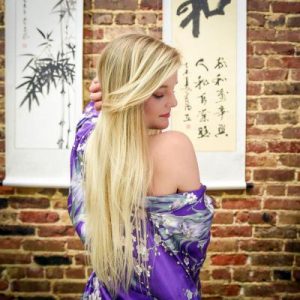Japanese kimonos are comfortable and stylish to wear. Kimonos are traditional Japanese clothing that was originally worn by a woman to cover their bodies during the Edo era. They have evolved somewhat over the many years and revived as a fashion trend now, especially in Tokyo where you can find many stores offering kimonos with all sorts of other trendy pieces.
Made from long pieces of fabric, Kimonos are sewn together along straight seams. A collar is attached to give it shape around the neck. The kimono is not cut specifically for each wearer but rather folds and drapes over them like a bathrobe and is held in place by tying an obi or sash around the hips and waist.
What is a common fabric used to make a kimono? Answers will vary but the most common ones made for today are cotton, cotton sateen, cotton slub, broadcloth, and silk sateen.
Cotton:
Cotton fabric is a favorite among many for its natural qualities. Cotton fibers are derived from seeds surrounding the flower of the cotton plants. These fiber strands come out in rounded formation when mature in colors ranging from white to light brown depending on geography and growing conditions.
This textile doesn’t contain any synthetic compounds, which means that it’s chemically organic. Cotton fabric is one of the most commonly used fabrics in the world. This material is very appealing because it can be used to make light or heavyweight clothing like shirts, sheets, pajamas, dresses, blouses, jackets, and especially Japanese kimono and yukata robes.
Cotton Sateen:
Sateen is a cotton fabric with a luster resembling that of satin. This fabric has the smoothness and glossiness that you would expect from satin. Cotton sateen is produced with the highest quality threads. It is among the most expensive cotton materials available.
It is highly breathable and has increased wear resistance because it has higher thread counts which give them durability without being too thin like some cheaper options. This material is often used to make sheets, pillowcases, and other items like the kimono yukata.
Cotton Slub:
Shantung or Slub cotton fabric has a unique look and feel. It contains spun cotton fibers providing a ribbed design effect. Slubbed yarns are woven into the material. This produces a durable, nubby fabric that maintains an airy feel with a textured and visual attraction.
Slub cotton is also called Tianzhu cotton in Japanese. This natural linen possesses better breathability than ordinary plain-knit cotton, making it an excellent choice for hot summer days and nights. Many customers like the look of this fabric for its retro appearance. It is more expensive than traditional cotton.
Broadcloth:
This fabric is typically used for clothing. It’s a sturdy, yet thin and medium weight fabric that can be found on everything from shirts to blouses or even bed sheets. Broadcloth fabric can be used for many different things. It’s tightly woven and very sturdy, making it perfect to use in the crafting industry or as an everyday shirt material because of its quality construction. High-end dress shirt makers often turn to broadcloth to make their best dress shirts.
Broadcloth clothing typically doesn’t need to be dry-cleaned. However, may need ironing or steaming to maintain its crisp, smooth appearance. Broadcloth will release odors easily in the wash. It is recommended to wash in cold water on the gentle cycle or washing by hand and tumble dry on low.
Silk Sateen:
Cherished for centuries, Silk Sateen has long been a popular choice. It’s made from the finest fibers and has long been respected as a finer fabric because it is woven from silk filament fibers. A Sateen Weave refers to a weaving technique in which three threads are woven over one thread.
This results in a smooth and sensual feel when running across the hand or body. Sateen fabric isn’t cheap. Silk runs on the higher end, to begin with, and when made into the finished sateen material, the labor increases the cost. Silk is a natural lightweight material that is very breathable and dries fast. Silk fabric regulates body temperatures well, so you feel cool in the summer and warm in the winter. This temperature-regulating feature is one of the reasons silk is in demand. Shop for Kimonos and Yukatas online.





